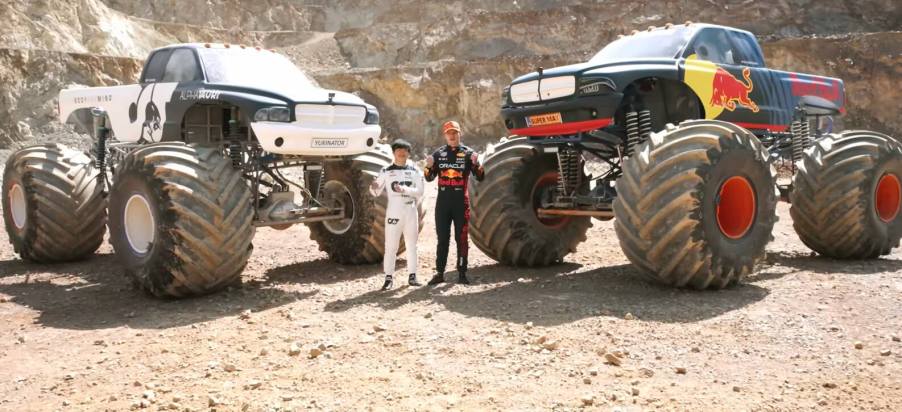
Watch Formula 1 Drivers Try to Figure Out Monster Trucks
Formula 1 drivers are the finest drivers in the world. Keeping a car that fast on the track for that long is quite a feat. You don’t have to know much about F1 to see the skill and bravery needed to be successful in this sport. However, despite the difficulty and danger, monster truck drivers don’t get the same kind of respect that F1 drivers get. Maybe that should change. Let’s see how two-time world champion Max Verstappen did against fellow F1 driver Yuki Tsunoda.
What are the differences between a monster truck and a Formula 1 car?
Other than the fact that they both have four wheels and an engine, there is almost nothing but differences. Formula 1 is often criticized because, to some, the cars win races, not the drivers. This is, of course, far too reductive to be true. But there is a nugget of truth to it. Formula 1 cars are the technological peak of the automotive world at any one time. These cars use everything from powerful engines to space-age aerodynamics to operate the way they do.
Formula 1 cars weigh about 1,760 lbs. For reference, one Monster Jam truck tire alone weighs at least 645 pounds. Add the weight of the wheel to that and it’s easy to see how close simply one wheel and tire on a monster truck could approach the weight of an entire F1 race car. F1 cars use a 1.6-liter engine making around 1,000 hp. Monster trucks use a massive V8 making only about 500 hp.
Now comparing these two extreme vehicles is pretty silly. I admit that. They aren’t supposed to do any of the same things. Monster trucks are like professional wrestlers, and F1 cars are like Olympic archers. Monster truck engines are meant to torque these trucks into the air and onto their back wheels for a kick-ass show. F1 cars are finely tuned to run around a series of tracks as fast as humanly possible. They simply aren’t comparable, but since two F1 drivers decided to try piloting monster trucks, we have to look at the two platforms this way.
How did Max Verstappen do against Yuki Tsunoda?
The two drivers both spent a little time warming up and learning the trucks by jumping and smashing cars, as you do. After warmups, the two both did qualifying laps individually. Yuki managed a 58.3-second lap, and in character, Max busted out a 55-second lap.
Both drivers mention how loud and harsh the trucks are. The cabin-mounted cameras even have a difficult time showing the drivers due to the extreme bouncing. On Max’s qualifying lap, you can even see dirt and mud splattering him inside the cabin. Despite having the faster lap, he also mentioned that his truck was misfiring. It’s clear that these trucks are rough and rowdy. The elegance and meticulous design at work in Formula 1 cars is nowhere to be found here.
Finally, the main event comes, and the two racers line up for a bit of wheel-to-wheel monster truck racing. While this is clearly not your average Monster Jam event, the show was still pretty good – well, until Max broke his truck. Yuki and Max line up and take off. Yuki’s truck, despite starting in second place, seemed faster off the line and quickly caught up with Max’s. By the second corner, Max’s truck experienced too many misfires, and his speed dramatically reduced. Yuki takes advantage of Max’s misfortune and wins the race.
Are monster trucks hard to drive?

Driving monster trucks is no simple task. Despite how badly we all wish we could drive one, the fact is, it’s harder than you think. The pros, even the F1 guys who were new to this type of driving, make it look pretty easy. However, like race cars, monster trucks have a ton of power and driving anything with 500+ hp in the dirt is a task. These trucks can have up to 1,500 hp and steer using the rear wheels.
In an interview with MotorTrend and Carl Van Horn, a monster truck mechanic and driver said, “Each driver is tested on a course set up to simulate a Monster Jam event by Monster Jam tech officials. This is usually a three-day test session, after which the officials will determine if that driver is capable of performing,” Carl explains. But how did he practice jumps? “You don’t really. Every event is a little more practice. The most common mistake is to not throttle all the way off the ramp, which causes the truck to nosedive. I think I did that off my first jump, and the landing was pretty rough, so I learned quickly not to do that again.”
Speaking of ramping, the reality of monster trucking is these 10,000+-lb trucks launch themselves as high as 30 ft in the air and smash back down to earth with all the grace of a buffalo on roller skates. Pros regularly flip them, both for show and accidentally. Between the ramping, gear shifting, throttle, braking, rear steer toggle switch, and the sheer size and power of these trucks, driving a monster truck is no joke.
As I’m sure many of you might feel now, I understand that it’s hard, but damn if I don’t want to drive a monster truck more than anything in this world. F1 guys get to have all the fun.






